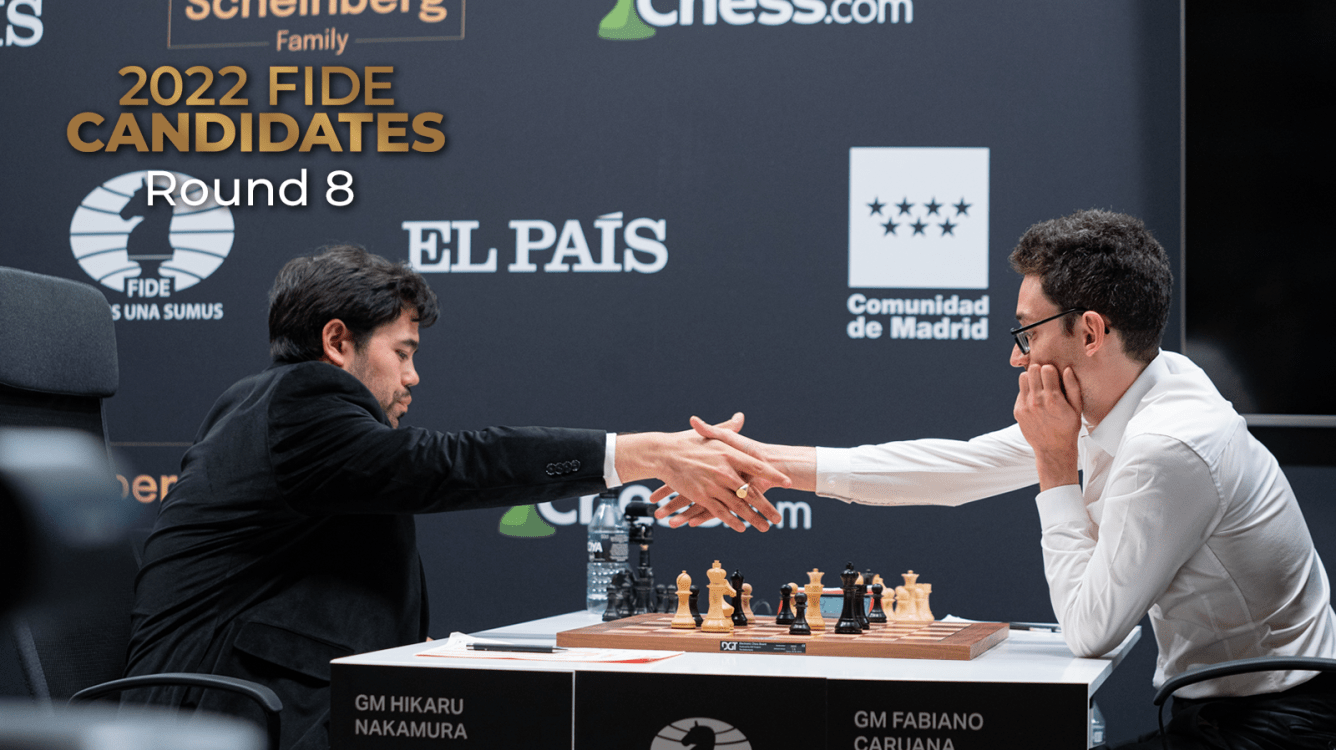
Nepomniachtchi Increases Lead With Quick Draw As Nakamura Beats Caruana
A quick draw with GM Ding Liren proved to be an excellent strategy for GM Ian Nepomniachtchi, who increased his lead to a full point at the 2022 Candidates Tournament on Sunday. GM Hikaru Nakamura, who beat runner-up GM Fabiano Caruana for the first time in a classical game in seven years, is now in third place.
GM Richard Rapport scored his first win in the tournament, bouncing back from his loss yesterday with a winning kingside attack against GM Jan-Krzysztof Duda. At the bottom of the leaderboard, GMs Alireza Firouzja and Teimour Radjabov drew a relatively quiet but also very long and tense game.
How to watch the 2022 Candidates Tournament
Coverage of round 9 begins on Monday, June 27 at 6 a.m. Pacific, 9 a.m. Eastern, and 15:00 Central Europe. You can watch the 2022 Candidates live on Chess.com/TV and on our Twitch, or catch all our live broadcasts on YouTube.com/ChesscomLive. You can also keep up with all the details here on our live events platform.
Nepomniachtchi-Ding ½-½
In this first round of the second half, the tournament leader played one of the quickest games so far. The whole act took just 55 minutes when the players had already been playing a few moves in an opposite-colored bishop endgame. When they started repeating moves, Ding at some point extended his hand to agree to a draw, but Nepomniachtchi pointed to his scoresheet and made sure the necessary repetitions would happen.
😅 Nepo-Ding finishes in a draw, but not without some handshake confusion! #FIDECandidates pic.twitter.com/EQ6xXe6Po8
— Chess.com (@chesscom) June 26, 2022
This quick draw made sense for both players. On +4, Nepomniachtchi has reached the stage where each half point is getting more valuable, and taking risks doesn't make any sense anymore. On top of that, he probably could use some extra rest, as well as more prep time for the big clash with Caruana tomorrow.
For Ding, who lost his game with Nepomniachtchi in the opening round, it would be too early to conclude that he has given up. It was more a case of his repertoire being excellent but limited; if you really only play 1...e5, it's tough to avoid what happened today.
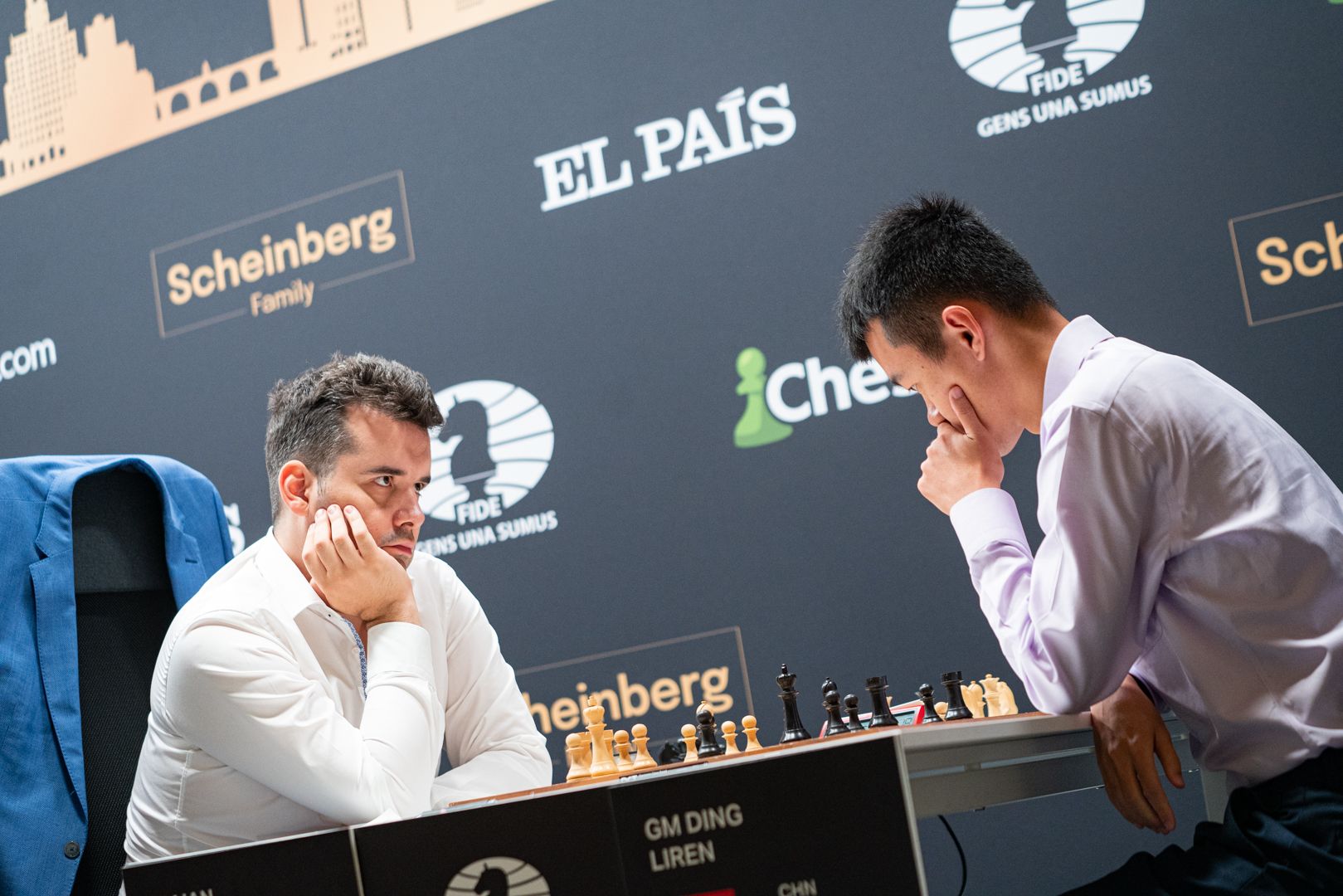
So how did the players reach that draw exactly? Well, Nepomniachtchi played the Scotch Four Knights, which, at the top level, almost always means the white player is playing for a draw. Theory was followed for a long time; only 21...h5 was the first new move. When all the rooks let the board, the peaceful result was inevitable.
Putting it bluntly, this was a non-game.
Annotations by GM Rafael Leitao.

Rapport-Duda 1-0
Rapport came off an unnecessary and highly disappointing loss the other day ("Maybe I should throw away the computer," he said afterward), and he had escaped with a draw vs. Duda in the first round. It must have been a relief for the Hungarian player to score a win today, while Duda couldn't hide his huge disappointment.

Known for regularly playing King's Indian Attack setups, Rapport had actually never played the 4.g3 Four Knights before (yes, a second Four Knights in the same round!). Afterward, he revealed that it was a decision at the board: "I didn't really look at chess after yesterday's game, I didn't even open Chessbase, actually."
I didn't really look at chess after yesterday's game, I didn't even open Chessbase, actually.
—Richard Rapport
With the unconventional 8.b3 the players left theoretical waters. After a bunch of trades, the game got interesting when Rapport pushed his g4-pawn up the board, eyeballing Black's "hook" on h6. Duda really had to act there, and he did wonderfully as he found two very nice moves with his h-pawn that temporarily sacrificed a pawn.
Position after 19...Nxg5.
Taking back on g5 with the knight was a further sign of Polish ambition, according to our commentators:
IM Danny Rensch: "Duda wants more than just an endgame."
GM Robert Hess: "He's willing to lose to increase his chances to win."

The tactics weren't over yet as Rapport found the neat intermediate move 22.Rg1, threatening checkmate on g7 before taking back the piece. GM Daniel Naroditsky, who joined the Chess.com broadcast for the first time today, had just shown it a few minutes earlier, calling it "a very good move in bullet and a good move in classical!"
The idea was to provoke 22…g6, which robs Black from his intended rook lift Re8-e6-g6/h6.
Is Duda surprised by @rjrapport’s in-between move 22.Rg1!?, tossing in a checkmate threat before recapturing the h3-bishop?
— ChesscomLive (@ChesscomLive) June 26, 2022
Or is @GM_JKDuda considering an astonishing move of his own: 22…f5!?#FIDECandidates pic.twitter.com/jVstv0rRBy
That Rg1 move might have shaken up Duda psychologically as he missed the most ambitious option of 22…f5 and then erred with 24...Rae7, a square the black king would have liked to run to in some lines. White suddenly had free play on the kingside, although Black did get one more chance.
Position after 25.Qf3.
On better days, Duda might have demonstrated that his opponent's 25.Qf3 was inaccurate due to 25…f6!!, the main idea being 26.g6 (26.gxf6 Rf7) Kf8 27.Qh5 Rb7 28.Qh8+ Ke7 29.Qxg7+? Ke6, and White's queen is trapped. As it went, he just got bulldozered on the kingside.
When Rapport had played his fancy final move, Duda looked completely dejected, shaking his head in disbelief and making hand gestures that suggested he didn't want to be anywhere near a chessboard.
♘ @RJRapport scores his first victory with a checkmating attack against @GM_JKDuda!#FIDECandidates pic.twitter.com/AUhpJYdBrT
— ChesscomLive (@ChesscomLive) June 26, 2022
After a few minutes, he stopped the clock with Rapport still away from the board. The winner quickly came back to shake hands when Duda left instantly. It was such a relatable moment as chess players know so well that feeling of complete disgust after losing. It happens to all of us.

Rapport is back on 50 percent after scoring his first win right after his first loss. Duda's -2 means that his tournament, where only first place counts, is basically over.
Annotations by GM Rafael Leitao.
The end of WGM Dina Belenkaya's interview with Rapport should not be missed:
Belenkaya: "I love your jacket; what made you wear it today?"
Rapport: "I would love to say something very confident, but actually my wife insisted on me wearing it yesterday. It proved to be very smart that I avoided that because it wouldn't have been fair against the jacket. So I chose to do it today."
Belenkaya: "Our audience was wondering, is this red, pink, or salmon color?"
Rapport: "I believe it's pink, but I guess it's up for debate."
Belenkaya: "Any strategy for the next games?"
Rapport. "I will think about my outfit, to confuse!"

Nakamura-Caruana 1-0
In what was their 47th classical game since 2010, Nakamura managed to score his first win vs. Caruana in seven years. After his win at Norway Chess in 2015, the head-to-head score was in fact 5-1 for Nakamura, but in the meantime, Caruana managed to turn that around, scoring seven wins and no losses since, including the first round of this Candidates. After today's game, Caruana still leads 8 to 6 with 33 draws.

It started as a heavy theoretical battle with Caruana playing the Dilworth variation of the Open Ruy Lopez, where Black gives two minor pieces for rook and pawn.
The Dilworth had never been played at the Candidates or world championship level before. It was seen, however, in a game between two future world champions back in 1943 as GM Mikhail Botvinnik tried it out against GM Vasily Smyslov in the Soviet Championship, having seen analysis published in Chess magazine by the English amateur correspondence player Vernon Dilworth (1916-2004). Smyslov won that game.
Seventy-nine years later, the Dilworth is known to be playable again, as it was seen in a few top-level games recently. It was GM Shakhriyar Mamedyarov who initially brought it back into the spotlight in a game with GM Maxime Vachier-Lagrave in 2018 in Biel. In January of this year, Caruana faced it with the white pieces against GM Jorden van Foreest in Wijk aan Zee, and then, seven weeks ago, Caruana tried it as Black himself against MVL.
Nakamura definitely saw it coming, studied it the night before, and criticized this opening choice in his own stream after the game:
"I think today being a streamer helped me, because I think Fabiano, for whatever reason, just assumed that I'm chilling on the beach all day, and I am not studying openings before this tournament. Because playing the Open Spanish, going into this whole line which is very sharp, it's just inexplicable honestly. I don't understand the decision by him at all. It's insane."
I don't understand the decision by him at all. It's insane.
—Hikaru Nakamura
15...Qd6 was new compared to Caruana's game with MVL game (where he played 15...Qd7), but it was actually Van Foreest's move. Despite, or more likely, because of all the theory that the players had to rehearse before the game, both Nakamura and Caruana actually mixed up their prep a little.
As GM Raunak Sadhwani explained in Chess.com's Indian broadcast, there was something wrong with Nakamura's quick reply 21.Ng3 to Caruana's 20…c5 novelty. He argued that 21.Ng3 is the best move according to the engine after 20…Rde8, but not after 20…c5, where 21.Bg5! Rde8 22.Nxe5! would have been possible.
In the official interview he didn't admit just yet that he made a slight mistake—perhaps because he needed to double check his analysis first—but in his own game recap which he makes each day from his hotel room (a fantastic service for the fans!) Nakamura did say that 21.Ng3 was inaccurate:
"The irony to me making a mistake is that if I'd played the line that I looked at last night and not confused variations, I probably would not have won this game."
According to Nakamura, 22…c4 was inaccurate (22…e4!) after which it was "positionally very tough to play for Black."
Especially Nakamura's 25.Nh1! was excellent regrouping, reminiscent of the classic Nimzowitsch-Rubinstein, Dresden 1926.
Positing after 25.Nh1!
Chess.com's VP of Content and International Sam Copeland joked: "I didn't think this would be a winning horse in this two-horse race!"
While Caruana was calculating 25…e4, Naroditsky commented: "He has to change his mindset, he's gotta go from 'I am looking for the kill shot' mode to 'it's just a complicated position, and I'm going to play something slow-mo' and that change of mentality can be hard if you've set yourself up with expectations about how good you think your position is."
It didn't get much easier for Caruana when his opponent found 27.h4!, called by Hess "one of the best moves in the entire tournament."

Around that time, Caruana was going under half an hour on the clock, with a bit more than an hour for Nakamura, who once again showed superb time management. Caruana used half of his remaining time on 27…Nc5, where 27…h5 was more or less the only move according to the engine.
Nakamura's advantage grew, and he won a pawn after trading queens. When his opponent had just two minutes left, he played the practically smart 38.b4, leaving Caruana with a dilemma: take en passant and weaken the structure, or accept a6 as a weakness for the remainder?
♙@gmhikaru plays the clever 38.b4! making a subtle yet key change to the position while ♝@FabianoCaruana is under time pressure!#FIDECandidates pic.twitter.com/VuZ1K2GvPR
— ChesscomLive (@ChesscomLive) June 26, 2022
That dilemma cost him another minute on the clock before Caruana played the losing move 38…h5.
Position after 38...h5.
Slightly surprisingly, Nakamura didn't want to deal the knockout blow just yet with either 39.Be8 or simply 39.Bxe4+, but what he did (39.a4) didn't seem bad either.
Caruana deserves credit for finding the fantastic defensive try 42...h3, but Nakamura's 34.Ra2 was equally great, and, in fact, the only move that kept a winning position. You know that Nakamura played a great game when Caruana's tremendous defense was not enough.
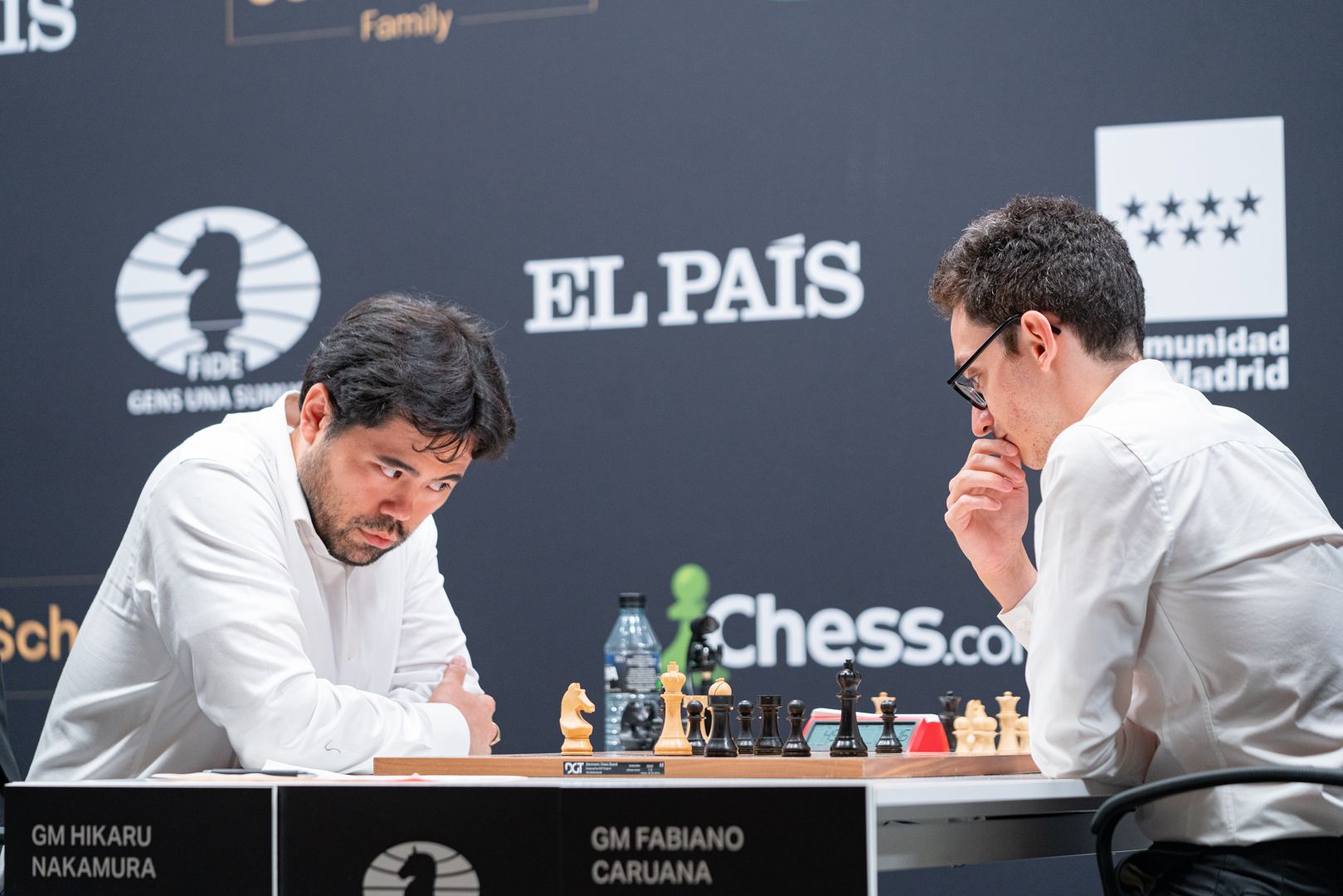
But the game was still not over. Caruana admirably kept fighting despite the engine showing +5 or +6 advantages for Nakamura—ignorance can be bliss in chess.
Finding 60…g5+! in this position, with which he narrowly made the second time control, was crucial for Caruana, who suddenly seemed to be getting some practical chances again. These hopes quickly vanished as the extra 15 minutes and the introduction of the 30-second increment were not enough to play perfect chess.
As he played 68.Bf2, Nakamura put on his coat, signaling that he felt the win was in the bag. Caruana still wouldn't give up, and that jacket had to go off again about 10 minutes later, but that was right when Caruana finally resigned, after a bit more than six hours of play.
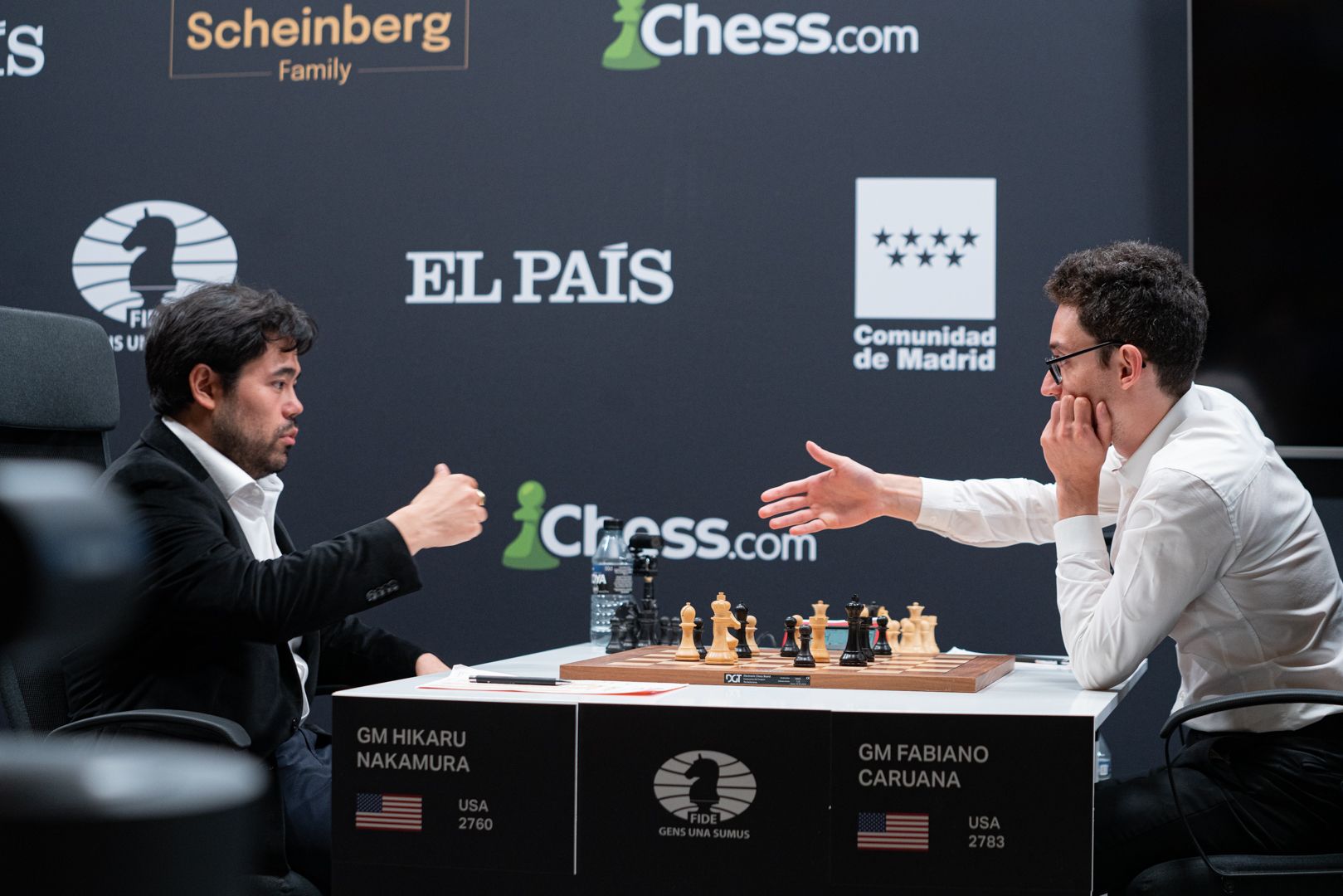
Nakamura won an incredibly rich game of chess, surged to third place in the standings, and is still in contention for first place. Not bad for a streamer. (That's not just a little joke; he actually stated today that on the next rest day he'll definitely be streaming Titled Tuesday!)
The eighth round of the candidates saw a shakeup of the standings with Hikaru beating one of the two main leaders. This is my first chance to annotate a game from one of my biggest childhood heroes in this tournament. He showed a fantastic intuitive feel for the position, winning in the same fine style I grew accustomed to seeing whenever I saw him on the top boards of countless American opens back when I was growing up.
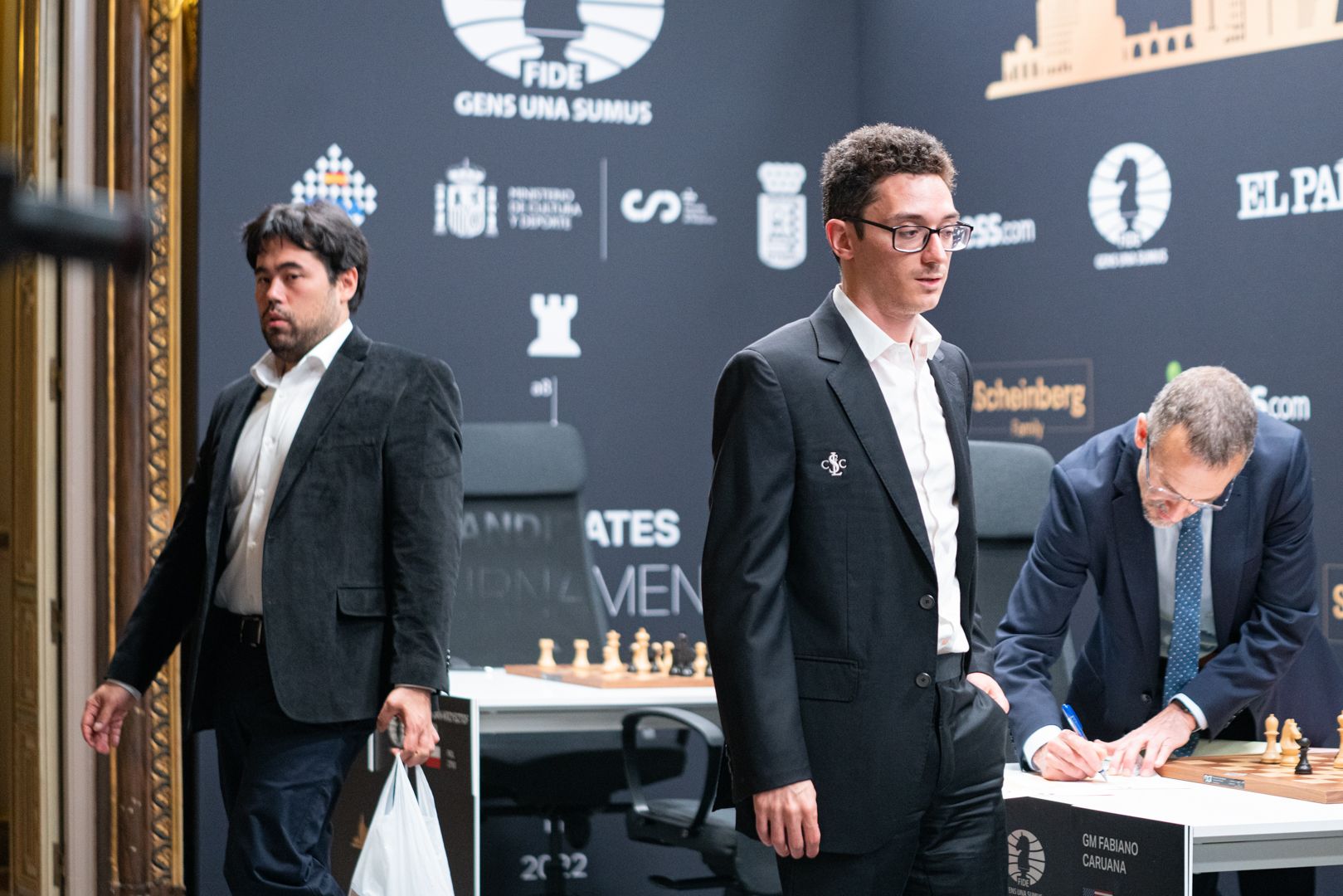
Firouzja-Radjabov
Anyone who clicked through this game without seeing our broadcast might conclude that not much happened, the eval bar always said equal, and it's time to move on. Behind this quiet-looking game, though, was a great fight between two players from different generations who were both hoping to score their first win—in the case of Radjabov, his first since October 2019.
One moment should be pointed out though: it looks like Radjabov had a tactic on move 26 where the engine likes Black but not with a huge margin. It was definitely a chance, though.
The final phase of the game, after move 70, was quite nerve-wracking as both players were down to about three minutes with a 30-second increment. It was blitz at the Candidates, with both players sometimes making a move with just a second left on the clock.
Seven hours into the game, @rajachess takes his king on an ambitious walk into @AlirezaFirouzja’s kingside!
— ChesscomLive (@ChesscomLive) June 26, 2022
An incredibly hard-fought 90+ move draw!#FIDECandidates pic.twitter.com/pGNqVV8xWI
After seven hours and two minutes, having played 93 moves, the players agreed to a draw by repetition and did so with a smile. What a round again, what a tournament!
Annotations by GM Rafael Leitao.
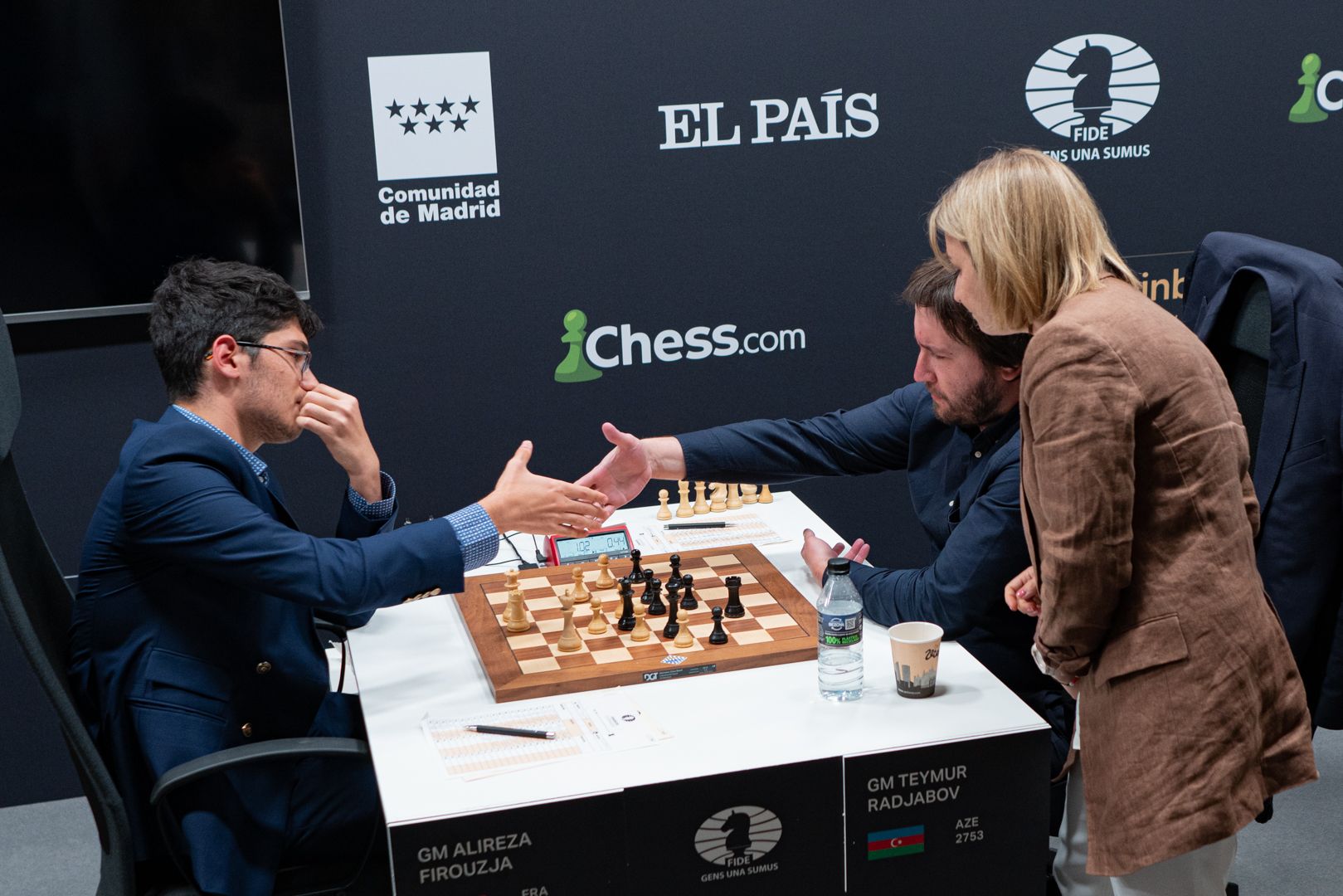
Round 8 Standings

Round 9 Pairings
| Round 9 | June 26, 2022 | 6 a.m. PT/15:00 CEST |
| Firouzja | - | Rapport |
| Radjabov | - | Nakamura |
| Caruana | - | Nepomniachtchi |
| Ding | - | Duda |
Previous coverage:
- Nepomniachtchi, Caruana Win Again To Extend Lead On Field
- Nepomniachtchi, Caruana Pick Up Wins In Spectacular 6th Round
- Nepomniachtchi Dodges Bullet, Maintains Lead In Madrid
- Nepomniachtchi Beats Firouzja, Storms To Sole Lead
- Impressive Defense By Nakamura On Day Of Draws
- Nakamura Bounces Back, Grinds Down Radjabov As Rivals Draw
- Caruana, Nepomniachtchi Win To Set Up Clash Of Leaders
- Caruana To Play His 4th Candidates: 'I Don't Actually Look At The Prize Fund'
- Which Candidate Has The Best Post-Pandemic Performance Rating
- Who Will Win The Candidates: The Case For Each Player
- Who Will Win The 2022 Candidates?
- 2022 FIDE Candidates Tournament: All The Information




